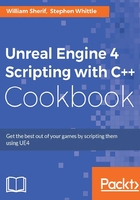
Chapter 2. Creating Classes
This chapter focuses on how to create C++ classes and structs that integrate well with the UE4 Blueprints editor. These classes are graduated versions of the regular C++ classes, and are called UCLASS.
Tip
A UCLASS is just a C++ class with a whole lot of UE4 macro decoration on top. The macros generate additional C++ header code that enables integration with the UE4 Editor itself.
Using UCLASS is a great practice. The UCLASS macro, if configured correctly, can possibly make your UCLASS Blueprintable. The advantage of making your UCLASS Blueprintable is that it can enable your custom C++ objects to have Blueprints visually editable properties (UPROPERTY) with handy UI widgets such as text fields, sliders, and model selection boxes. You can also have functions (UFUNCTION) that are callable from within a Blueprints diagram. Both of these are shown in the following screenshots:

On the left, two UPROPERTY decorated class members (a UTexture reference and an FColor) show up for editing in a C++ class's Blueprint. On the right, a C++ function GetName marked as BlueprintCallable UFUNCTION shows up as callable from a Blueprints diagram.
Note
Code generated by the UCLASS macro will be located in a ClassName.generated.h file, which will be the last #include required in your UCLASS header file, ClassName.h.
The following are the topics that we will cover in this chapter:
- Making a
UCLASS– deriving fromUObject - Creating a user-editable
UPROPERTY - Accessing a
UPROPERTYfrom Blueprints - Specifying a
UCLASSas the type of aUPROPERTY - Creating a Blueprint from your custom
UCLASS - Instantiating
UObject-derived classes (ConstructObject <>andNewObject <>) - Destroying
UObject-derived classes - Creating a
USTRUCT - Creating a
UENUM() - Creating a
UFUNCTION
Tip
You will notice that the sample objects we create in this class, even when Blueprintable, will not be placed in levels. That is because in order to be placed in levels, your C++ class must derive from the Actor base class, or below it. See Chapter 4, Actors and Components for further details.